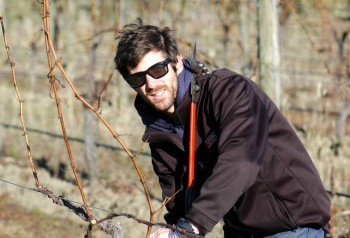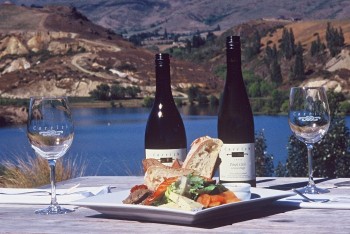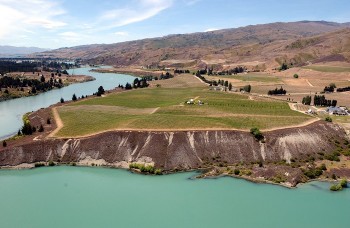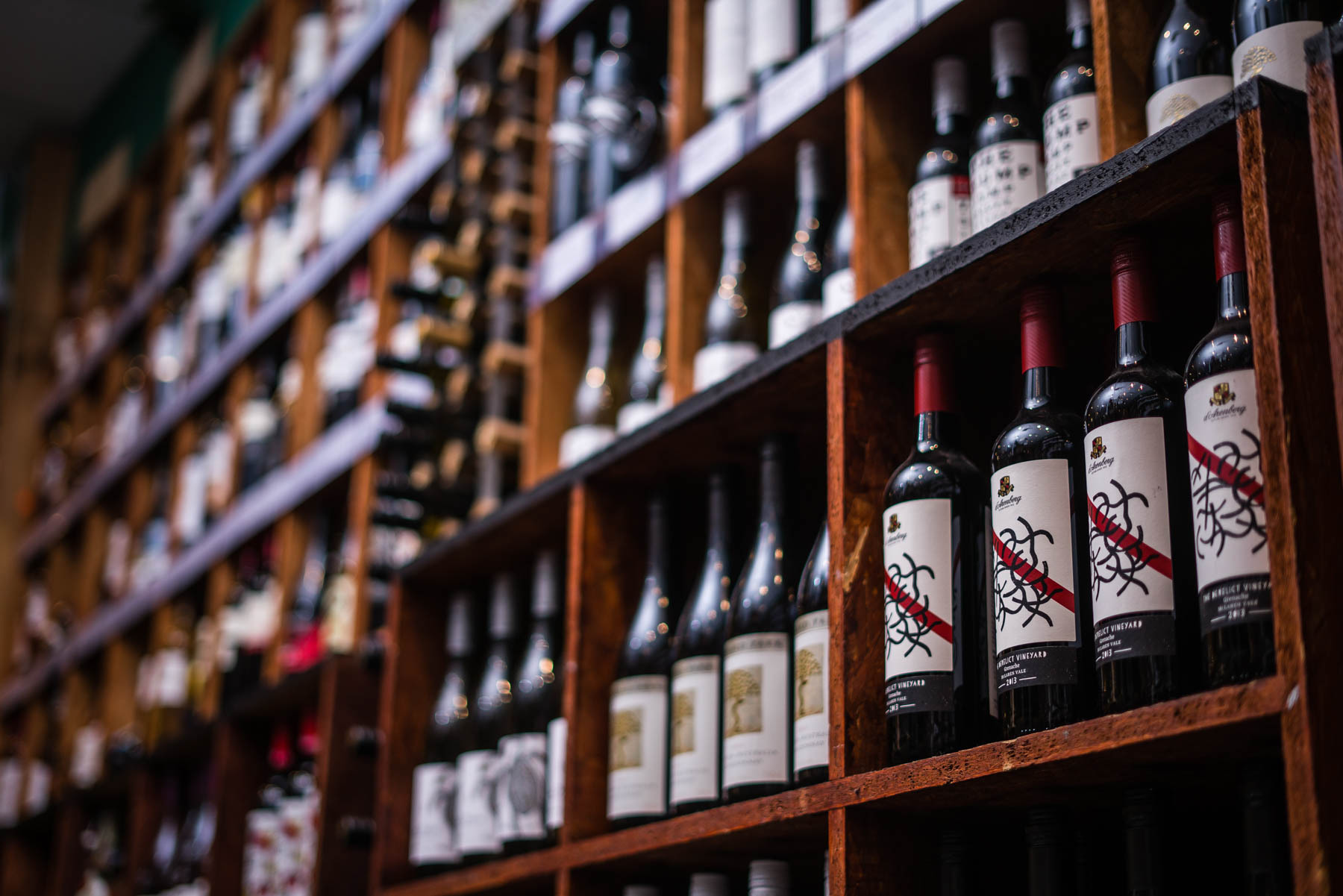Central Otago - The Glittering Gem
Laura on 12 Apr 2015
By Angela Mount
What’s the most Southerly wine producing region in the world? Well, that would be New Zealand’s Central Otago, nestled way down south, in the spectacular beauty of the country’s South Island - a mind-blowing contrast of snow-capped mountains, glittering lakes, wild forests, craggy hills, and wind-stormed oceans.
This dramatic landscape and climate - short, intense summers; harsh, frosty winters; and the lowest rainfall in the country - has helped bring some truly world class wines to the world. It’s the dream home for Pinot Noir, Sauvignon blanc and Riesling, which all crave cool, European-like conditions.
With its now stellar fame and reputation, it’s hard to believe that the first commercial bottlings in Central Otago only happened in 1987, less than 30 years ago. Their rise to fame has been nothing short of spectacular.
 New Zealand is a country, or rather two islands, which are multifaceted, jaw-droppingly beautiful, and home to a fiercely proud and ambitious nation of people. There’s far more to New Zealand wines than Sauvignon Blanc and Marlborough.
New Zealand is a country, or rather two islands, which are multifaceted, jaw-droppingly beautiful, and home to a fiercely proud and ambitious nation of people. There’s far more to New Zealand wines than Sauvignon Blanc and Marlborough.
We know about the heritage and history of centuries of winemaking from France and Italy, so it’s sometimes difficult to comprehend that wines from New Zealand only really began to be made seriously in the 1970s. The speed of the world’s discovery of the magical quality of this country’s wines has been phenomenal.
There’s over 1400km distance from the tip of the North Island to the end of the South Island, and this makes a huge impact on which grapes are grown where. Merlot and Cabernet Sauvignon work well in the warmer climes of the North Island; but I’m taking you south to Central Otago, which is about as far south as you can go in the world in terms of winemaking, and where the gloriously temperamental and maverick Pinot Noir shines in true splendor.
 The grapes
The grapes
Central Otago accounts for only 3% of New Zealand’s total wine production, but what it does produce is top notch stuff. It’s pretty brutal in terms of weather and landscape – it has the highest mountains in the country, and the harshest of climates, but it’s an area that just happens to produce wines that angels helped to create, in their glory and sumptuous elegance. It also happens to be a region of breathtaking beauty.
Pinot Noir, with its temperamental needs, is beautifully suited to this land and accounts for over 60% of plantings. It has catapulted the area to worldwide fame in recent years with the sheer majesty of its wines.
It’s too cold here to bring other red grape varieties to ripeness, but it’s also a perfect Southern Hemisphere home for the delicate Riesling, Pinot Gris, and Gruner Veltliner, as well as some deliciously fresh Chardonnay.
A land of contrasts
Central Otago, with the city of Queenstown at its centre, was first discovered in the 19th century, during the Central Otago gold rush. These days, vines thrive on the mineral-rich soils where gold miners used to dig. It’s a region of extremes, protected from the extreme harshness of the cold, maritime climate by the soaring mountains.
For a relatively small area there’s lots of variation in styles of wine between the main sub-regions, purely due to the differences in climate, terrain and aspect. In a land of towering mountains, deep ravines, ice-cold lakes, and extreme weather conditions, 6 small areas have brought to the world some truly stellar wines.
It’s the coldest, yet the driest, region in the country - short, hot summers, cool autumns and harsh, cold winters, with lots of snow and frost; the lowest recorded temperature was -21 c back in 1995.
The vintage here happens about 6 weeks later than for vineyards in the North Island, due to the colder climate, and the need for a longer growing season. It’s also the reason why the fickle, and high maintenance Pinot noir, whose natural environment is the cold, northern region of Burgundy, thrives so well here, as do other grapes that have traditionally thrived in cold and often mountainous conditions, such as Riesling and the Austrian Gruner Veltliner.
 Vines were first planted in the late 19th century, with some experimental vineyard plantings in the 1950s, but it was only from the 1970s onwards, that the region began to expand as a wine producer. In 1996, there were only 11 wineries, and only 92 hectares of land under vine.
Vines were first planted in the late 19th century, with some experimental vineyard plantings in the 1950s, but it was only from the 1970s onwards, that the region began to expand as a wine producer. In 1996, there were only 11 wineries, and only 92 hectares of land under vine.
Nowadays, many of the traditional cherry and apricot fruit orchards have been uprooted, and vines planted, with a rapid increase to just under 2000 hectares given over to vine growing.The number of wineries has grown in proportion.
The wines from this area will never be cheap – harsh conditions, small production, temperamental grapes – but they have a glorious purity, and depth of style, and a cool aristocracy.
It’s difficult not to refer to scenes from the Lord of the Rings Trilogy when talking about the scenic and breathtaking landscape. For those of you who have watched these films over and over, Arrowtown and its surrounding area, close to Queenstown, was the location for the filming of several scenes, including the Gladden Fields. Drive over the mountain range and up to the peaks and from the top of Mount Cardona intrepid climbers are able to view the spectacular and panoramic vistas that Director Peter Jackson filmed to depict Middle Earth.
Bannockburn
Let’s start with one of the best known sub-regions of Central Otago, producing some of the most complex wines, and with a unique story: Bannockburn lies on the south side of the Kawarau River, at the southern end of the Cromwell Basin. This is where the gold miners first found success back in the 1860s, and it’s known as ‘the heart of the desert’, with its glistening soils of loam and silica. One of the glittering gems that has emerged from this old mining area is Carrick, a winery founded by the ebullient and highly-focused Steve Green, and his wife Barbara. Before 1994, the land was covered in wild herbs, flowers and fruit trees; now the winery is one of the most respected in the region.
 I met Steve on his last visit to UK, and his passion for what he is creating is infectious. He not only champions his own wines, he’s a worthy ambassador for Central Otago itself. He is understandably proud of the fact that he is crafting world class wines in the world’s most southerly wine producing region. His range of Pinot Noirs is outstanding, and presents a thoroughbred elegance throughout, with finely tuned layers of beguiling flavours.
I met Steve on his last visit to UK, and his passion for what he is creating is infectious. He not only champions his own wines, he’s a worthy ambassador for Central Otago itself. He is understandably proud of the fact that he is crafting world class wines in the world’s most southerly wine producing region. His range of Pinot Noirs is outstanding, and presents a thoroughbred elegance throughout, with finely tuned layers of beguiling flavours.
The popular Carrick Unravelled Pinot Noir is a gorgeous example of approachable, affordable, yet very fine, Pinot; bursting with sumptuous red berry fruit and warm spice velvetiness. But there’s far more to Carrick than just Pinot Noir.
Their stylish Carrick Chardonnay has more than a hint of textured Burgundian style; restrained, yet ample in its complexity. I love their aromatic styles, which range from a lime-streaked, gooseberry- infused Sauvignon Blanc, to the delightful, vibrant, pink grapefruit and honeysuckle-scented Carrick Riesling.
Gibbston
Move on east of Queenstown, and discover Gibbston, which is the highest positioned of Central Otago’s sub-regions, nestled in a tight valley,alongside the spectacular Kawarau gorge. Here the vintage comes later, and the wines are some of the most delicate in Central Otago.
 Marlborough-based Yealands make a single vineyard wine from Gibbston, with grapes sourced from the Holtzmans Vineyard situated 320 metres above sea level. Winemaker Tamra Kelly-Washington says she’s always had a soft spot for the wines from Gibbston, and was over the moon when she could secure a vineyard in the area. The grapes arrive at their Marlborough winery after an 11 hour journey by refrigerated truck; the perfect amount of time for giving them a pre-fermentation ‘cold soak which has the benefit of extracting extra colour and flavour from the grapes.
Marlborough-based Yealands make a single vineyard wine from Gibbston, with grapes sourced from the Holtzmans Vineyard situated 320 metres above sea level. Winemaker Tamra Kelly-Washington says she’s always had a soft spot for the wines from Gibbston, and was over the moon when she could secure a vineyard in the area. The grapes arrive at their Marlborough winery after an 11 hour journey by refrigerated truck; the perfect amount of time for giving them a pre-fermentation ‘cold soak which has the benefit of extracting extra colour and flavour from the grapes.
This juicy, cherry and plum flavoured Pinot was recommended by Sunday Express wine columnist Jamie Goode recently:
"This is such an impressive Gibbston Pinot, showing fresh, meaty, dense, spicy red cherry and berry fruit, with real freshness and a silky texture. It’s just so beautiful, with lots of aromatic interest and real palate presence."
So, if you have the chance to visit, please do so, and you’ll see for yourselves the magical, spectacular, uncompromising beauty of this southern outpost. But if you can’t just yet, pour yourself a glass of Pinot Noir, and dream.
By Angela Mount

